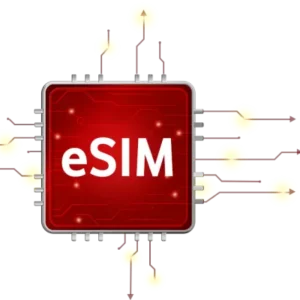
Travel eSIM Market to Reach $260B by 2034, Led by Asia-Pacific
The Global Travel eSIM Market size is expected to be worth around USD 2,60,735 Million By 2034, from USD 2030.8 Million in 2024, growing at a CAGR of 62.50% during the forecast period from 2025 to 2034. In 2024, Asia-Pacific held a dominant position in the Travel eSIM market, capturing over 56.7% of the market share and generating USD 11.5 million in revenue.
A Travel eSIM is an embedded SIM technology that allows mobile device users to activate a cellular plan from a carrier without the need for a physical SIM card. This technology is particularly advantageous for travelers, as it enables them to switch operators globally without replacing the SIM card. An eSIM can hold multiple profiles and manage several accounts, offering seamless connectivity and cost-effective data plans across different countries.
The Travel eSIM market is experiencing rapid growth due to increasing global travel and the proliferation of eSIM-enabled devices. This market includes telecommunications companies, technology service providers, and eSIM platform developers who create solutions that cater to the needs of international travelers. The sector is driven by the rising demand for more flexible and affordable roaming alternatives and the growing number of partnerships among global telecom providers.
![]()
The primary driving factors of the Travel eSIM market include the surge in international travel, the expansion of IoT applications, and the need for improved network management capabilities. Additionally, the growing consumer preference for smart devices and wearables that support eSIM technology further accelerates market growth.
Market demand for Travel eSIMs is bolstered by the increasing mobility of the global workforce and the need for continuous connectivity. As businesses expand their operations internationally, the requirement for accessible and efficient communication channels drives the demand for eSIM technology. Consumers and enterprises are increasingly aware of the benefits of eSIMs, such as cost-effectiveness, improved device functionality, and enhanced security, which contribute to the sustained market demand.
According to Kaleido Intelligence, The travel eSIM market is witnessing a remarkable surge, with retail spending projected to reach $3.3 billion by 2025, reflecting a 165% growth from 2023. This growth highlights the increasing reliance on eSIM technology by international travelers, driven by its convenience and cost efficiency. By 2028, travel eSIMs are expected to account for 28% of total travel connectivity spending, including roaming, traditional SIMs, and digital solutions.
Affordability is a key driver, with the average spend per travel eSIM expected to remain below $15 in the coming years. Combined with a projected 50% annual growth rate, this trend is fueled by the widespread adoption of eSIMs in mid- and low-tier smartphones, as well as the availability of budget-friendly data plans.
Travel eSIM adoption is set to grow by nearly 50% annually over the next four years, fueled by a shift away from physical SIM cards, the rollout of eSIM support in mid- and lower-tier smartphones, and increasingly affordable data plans. With average spending expected to stay below $15 per trip, travelers are finding eSIMs to be a budget-friendly and hassle-free alternative.
Technological advancements in eSIM technologies are continuously evolving, improving the security and functionality of eSIMs. Modern eSIMs support high-speed data services, are compatible with a range of devices, and offer enhanced operational efficiency by allowing users to manage their plans directly from their devices.
The travel eSIM market presents various opportunities, particularly in enhancing the customer experience through improved service offerings like instant activation and widespread coverage. There is potential for partnerships between eSIM providers and travel agencies or airlines to offer bundled connectivity solutions, enhancing the overall travel experience.
 Key Takeaways
Key Takeaways
- The Global Travel eSIM Market is projected to reach USD 2,60,735 Million by 2034, growing from USD 2030.8 Million in 2024, with a CAGR of 62.50% during the forecast period from 2025 to 2034.
- In 2024, the Smartphones segment dominated the travel eSIM market, holding more than 76.8% of the market share.
- The Individual Travelers segment also led the Travel eSIM market in 2024, capturing more than 61.9% of the market share.
- In 2024, the Asia-Pacific region dominated the Travel eSIM market, accounting for more than 56.7% of the market share, generating USD 11.5 billion in revenue.
China Travel eSIM Market Size
China’s leadership in the travel eSIM market is evident with a robust growth forecast, emphasizing its progressive adoption of digital connectivity solutions. The market, which stood at USD 556.1 million in 2024, is underpinned by several key factors that fuel its expansion.
One of the primary drivers is China’s large-scale implementation of eSIM technology across various consumer devices, including smartphones, tablets, and wearables, particularly favored by a tech-savvy population. This widespread adoption is facilitated by major telecom operators in the region, who are investing heavily in eSIM infrastructure to offer flexible and cost-effective data plans to both domestic and international travelers.
Moreover, China’s competitive edge is further sharpened by the presence of major eSIM technology providers and robust partnerships between telecom operators and device manufacturers. These collaborations enhance the integration and management of eSIM technologies, making China a leading player in the global arena.
In 2024, Asia-Pacific held a dominant market position in the travel eSIM market, capturing more than a 56.7% share, amounting to USD 11.5 million in revenue. This region’s leadership in the market can be attributed to several key factors, including high mobile penetration rates, significant advancements in mobile network infrastructure, and a strong presence of key eSIM technology providers.
Another driving force behind the growth of the Travel eSIM market in Asia-Pacific is the increase in international tourism and business travel originating from the region. As travel frequencies rise, so does the demand for cost-effective and convenient communication solutions. eSIM technology offers travelers seamless connectivity across borders, eliminating the need for SIM card swaps and high roaming charges.
Governments across Asia-Pacific have been proactive in promoting IoT and smart technologies, which include the adoption and implementation of eSIMs. These regulatory frameworks not only encourage the proliferation of eSIM technology but also attract investments from global telecom giants looking to capitalize on the growing digital consumer base in the region.
Moreover, strategic collaborations and partnerships between local mobile operators and international travel agencies or airlines have enhanced the availability and accessibility of eSIM services in the Asia-Pacific market. These partnerships help streamline the distribution channels for eSIM services, making it easier for consumers to access these technologies.
![]()
Device Type Analysis
In 2024, the Smartphones segment held a dominant market position within the travel eSIM landscape, capturing more than a 76.8% share. This segment’s leadership is primarily attributed to the widespread ownership and use of smartphones globally.
Smartphones are integral to the daily lives of millions, serving not only as communication tools but also as primary devices for navigation, travel booking, and payment while traveling. The integration of eSIM technology into smartphones greatly simplifies connectivity for travelers, allowing them to switch carriers without the physical constraints of traditional SIM cards.
The predominant use of smartphones as travel companions contributes significantly to the segment’s dominance. These devices are most travelers’ first choice for maintaining connectivity, due to their portability and multifunctionality. The ease with which eSIMs can be activated on smartphones also plays a crucial role.
Moreover, manufacturers are increasingly embedding eSIM technology in their smartphone models, pushing the boundaries of what’s possible with connected devices. Major smartphone manufacturers have committed to eSIM technology, viewing it as a key feature for future models.
![]()
End-User Analysis
In 2024, the Individual Travelers segment held a dominant market position within the Travel eSIM market, capturing more than a 61.9% share. This substantial market share is primarily attributed to the rising trend of solo travel and personalized travel experiences among consumers worldwide.
Individuals increasingly seek flexible and convenient communication options while traveling abroad, driving the adoption of eSIM technology that eliminates the need for multiple physical SIM cards and facilitates seamless cross-border mobile connectivity.
The proliferation of digital nomadism and the shift towards remote work arrangements further fuel the demand within this segment. As more people embrace the possibility of working from any location, the necessity for uninterrupted and affordable internet access becomes critical.
Moreover, advancements in smartphone technology and the growing integration of eSIM capabilities by leading mobile device manufacturers have made it easier for individual travelers to utilize eSIM services. As major smartphone brands adopt eSIM technology, users can easily switch networks and manage services based on travel needs without sacrificing connectivity or facing high costs.
Final thoughts about the global travel eSIM market
The travel eSIM market’s growth reflects rising demand for seamless and cost-effective global connectivity. Beyond travelers, businesses are leveraging eSIMs to support remote teams and streamline international operations. With the expanding adoption of affordable devices and IoT, eSIMs are reshaping digital communication. Strategic partnerships and evolving regulations will further enhance connectivity solutions, driving innovation and unlocking new opportunities for consumers and businesses alike.
- AIRALO
-
eSIM for
Europe
39 countries
-
1 GB – 7 days – €4.27
3 GB – 30 days – €11.09
10 GB – 30 days – €31.57
- AIRHUB
-
eSIM for
Europe
34 countries
-
1 GB – 7 days – €2.99
3 GB – 30 days – €5.12
10 GB – 30 days – €11-09
- aloSIM
-
eSIM for
Europe
32 countries
-
1 GB – 7 days – €5.00
3 GB – 30 days – €13.00
10 GB – 30 days- €36.00
- GigSky
-
eSIM for
Europe
36 countries
-
1 GB – 7 days – €6.99
3 GB – 15 days – €11.19
10 GB – 30 days – €27.99
- iRoamly
-
eSIM for
Europe
39 countries
-
1 GB – 7 day – €6.83
3 GB – 15 days – €10.24
10 GB – 30 days – €18.77
- Maya Mobile
-
eSIM for
Europe
34 countries
-
1 GB – 7 days – –
5 GB – 15 days – €5.99
10 GB – 30 days- €13.99
- NOMAD
-
eSIM for
Europe
36 countries
-
1 GB – 7 days – €4.71
3 GB – 15 days – €10.27
10 GB – 30 days – €15.41
- UBIGI
-
eSIM for
Europe
29 countries
-
500 MB – 1 day – €2.00
3 GB – 30 days – €8.00
10 GB – 30 days – €19.00
- VOIA
-
eSIM for
Europe
34 countries
-
1 GB – 7 days – €2.69
3 GB – 15 days – €5.05
10 GB – 30 days- €11.70





 Key Takeaways
Key Takeaways












